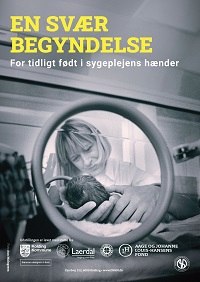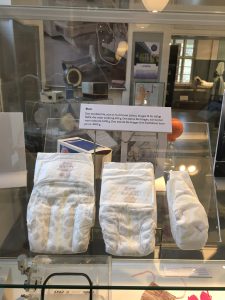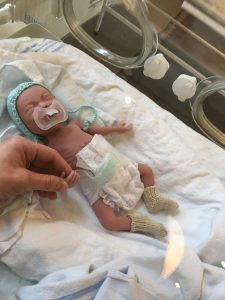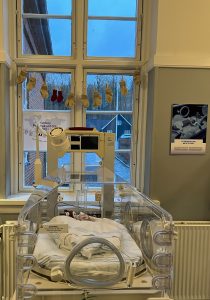A guest article by Sarah Fügenschuh
When we imagine modern neonatal care, in industrialised nations in particular, we might think of Neonatal Intensive Care Units (NICUs) equipped with state-of-the-art technical and medical appliances, the involvement of parents in the care of their hospitalised child, Kangaroo Mother Care, patient-centred treatment and follow-up care, and a relationship between healthcare professionals and parents at eye level. If one were to imagine a NICU in Denmark to be like this, one would not be wrong. Yet the journey there was an exciting and eventful one.
The exhibition “A difficult beginning – born too early in careful hands” (in Danish: “En svaer begyndelse – for tidlig født i sygeplejens hænder”), housed at the Danish Museum of Nursing History in Kolding, Denmark, showcases the impressive journey of care giving for preterm infants in Denmark from the 20th century until today and illustrates how the achievements of modern nursing care had to be earned through continuous learning and the courage to change.
Neonatal care in its infancy

An incubator from the 1970s. At the time, an incubator cost as much as a Volkswagen. © H. Stentoft/Dansk Sygeplejehistorisk Museum
In 1965, the first neonatal care unit, with medical staff separate from obstetrics and paediatrics, opened in Rigshospitalet in Copenhagen, Denmark as one of the first of its kind in Europe.[1] In fact, until the middle of the 20th century, there were hardly any facilities throughout Europe that could adequately treat and care for preterm or sick newborns, and neonatology was still in its infancy. In Denmark’s first NICU, keeping the babies warm, reducing the risk of infection, and ensuring nutrition were the top priorities. Parents only had contact with their baby after a certain period of time and strict hierarchies characterised the relationship between parents, nurses, and doctors.[2]
The impetus for the exhibition came when curator Heidi Stentoft was in dialogue with three retired neonatal nurses from the local hospital, while working on an article on the topic of neonatal nursing. After the article was published, she, being a nurse herself, realised that there was still so much more to tell. Hence, the idea was born to dedicate an exhibition to the history of neonatal care with a focus on the care of preterm and sick newborns.
It took a good two years to design and put together the exhibition. “During the time of preparation we realized that preterm birth really is a topic that affects so many people in so many ways. Be it because some are professionally involved or because they were personally affected as parents or siblings or as former preterm babies”, recalls museum manager Trine Gjesing Antvor.
She remembers one incident shortly after the opening in particular. “A group of students had come to visit and I asked their bus driver whether he wanted to pop inside and have a look while the group did the tour. He politely declined, stating the topic wasn’t for him and that he had some paper work to do anyway. However, a little later I saw him standing in front of one of our info posters and seemed really touched by what he had seen. He then told me that he himself was a grandfather to a preterm born child. It was probably the first time he actually spoke about this with someone else.” The exhibition therefore strives to be appealing and informative for health professionals and laypeople alike yet it deals sensitively with certain topics such as intensive care measures for extremely preterm babies.
With a balanced mix of facts and personal experience reports from contemporary witnesses, carefully selected artifacts, and testimonials from parents, nurses, and doctors, the exhibition reveals how technology, but also methods and attitudes, have changed rapidly since the 1950s.
- A visual comparison: Nappies for very preterm, preterm and term born babies. © S. Fuegenschuh/EFCNI
- A hands-on museum: Visitors may touch the modern incubator and the doll of a 24 weeker. © S. Fuegenschuh/EFCNI
Nurses as the drivers of change

Kangaroo Mother Care (KMC): Firstly introduced in 1985, KMC is now a national standard. ©Jørgen Kølle/Dansk Sygeplejehistorisk Museum
Visitors also learn a lot about the role of nurses in neonatology and how they were involved in its transformation. A quote from a nurse from the 1970s illustrates this very vividly: ‘I remember one day when nurse Ruth took the baby out of the incubator and let the mother touch it. We were completely shocked!’. “Nurses were the drivers of change”, notes Trine Gjesing Antvor. “Thanks to their closeness to the patients and the parents, combined with experience and intuition, they were able to contribute to the optimal care and initiate and implement new ways of providing that care”.
Housed in a former children’s tuberculosis hospital from 1911, the museum invites for retrospection, however, the exhibition addresses current problems and discussions as well; for instance, the issue of personnel and time resources. As technical possibilities will undoubtedly continue to develop, the question is whether there will be sufficient skilled and experienced medical staff that feels satisfied in the way they can meet the patients’ and the parents’ needs.
EFCNI is thrilled and honoured to be featured in this exhibition with the World Prematurity Day logo and the socks line, which was knitted by volunteers with great attention to detail.
The exhibition will be open until November 2024. For further information please see the details and links below.
 About the exhibition:
About the exhibition:
The exhibition “A difficult beginning – born too early in careful hands/En svaer begyndelse – for tidlig født i sygeplejens hænder” is hosted by the Danish Museum of Nursing History/Dansk Sygeplejehistorisk Museum and can be visited until November 2024. Please note this temporary exhibition is in Danish. An exhibition guide in English is available upon request. The permanent exhibition is in Danish and English. Link to the Danish website: https://dsr.dk/sygeplejemuseet/aktuelle-udstillinger/
About the Danish Museum of Nursing History:
For opening hours, admission fees, and contact information, please click here: https://dsr.dk/sygeplejemuseet/danish-museum-of-nursing-history/ (website in English)
___________________________________________________________________
[1] Greisen G. Managing births at the limit of viability: the Danish experience. Semin Fetal Neonatal Med. 2004 Dec;9(6):453-7. doi: 10.1016/j.siny.2004.08.003. PMID: 15691783.
[2] C. Sommer, H. Stentoft.Varme, mad og forebyggelse af infektioner. Sygeplejersken. Danish Journal of Nursing. 2024 Jan. 124th edition.




